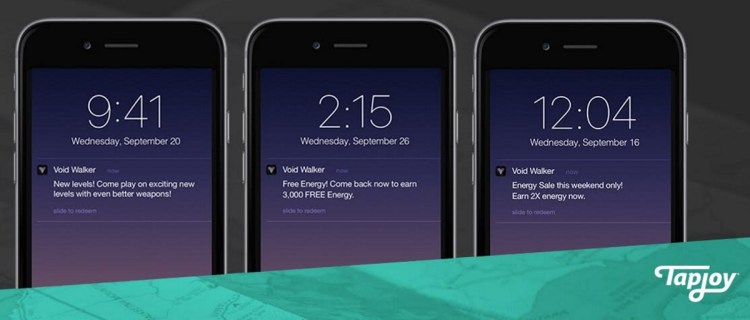Tapjoy, the mobile marketing company, has come up with seven surprising facts about the open rates for push notifications.
Push notifications are a common way to get users to pay attention to an app. Marketers love push notifications because users can’t help but see them as they flash across the screen of their smartphones. It’s like tapping a user on the shoulder, Tapjoy says. But just as in real life, a notification risks interrupting or annoying users if not done right. Every misstep reduces open rates, and, in turn, retention and engagement. Notifications, in short, are both a powerful tool and a minefield for app developers, according to San Francisco-based Tapjoy.
Tapjoy has accumulated data from its network of 500 million users and studied over 4.4 million push notifications sent between February and August, 2016.
Here are the key findings in the company’s own words (below):

Above: Notification open rates by day.
Fact No. 1: Open rates are highest on Mondays.
Notifications sent early in the week have the highest open rates: As users approach Friday and Saturday, the imminent end of the work week and upcoming vacation days seem to draw their attention away from their phones. But by Sunday, notification conversions are on the rise again.
So you know the best days — but what about the right hour? Just after lunch, it turns out. A case study with partner developer Nekki showed that Tapjoy’s push notification solution lifted average revenue per daily active user (ARPDAU) by up to 46 percent for a targeted sale campaign by sending notifications in each country’s native language at mid-day in their local time zones.
Fact No. 2: Android makes opening easier.
Developers are going to see better conversions from Android campaigns. The data reveals that Android users have higher open rates, at 3.10 percent versus the 2.38 percent seen on iOS. That’s a 30 percent edge.
There are definite factors behind these rates, one of which may be how each platform receives push notifications. On Android, a notification stays on the lock screen for as long as the user doesn’t interact with it. On Apple, notifications move to the notification tray once the user unlocks their phone.
Fact No. 3: Weekly frequency gets opened the most.
Like “Goldilocks and the Three Bears,” app users don’t like too much or too little in their notifications. The “just right” point for scheduled notifications appears to be weekly, with a 3.03 percent open rate, while daily or monthly deliveries are opened much less.
It should be pointed out that while daily notifications have the lowest open rate, that doesn’t mean they’re worthless — over the 7 days of a week, you’ll get more opens from your daily notifications than weekly, even with a lower percentage rate. But it’s important to make sure that you aren’t spamming or annoying your users with daily notifications.

Above: Here’s what users open the most when it comes to push notifications.
Fact No. 4: The phrase “Get your…” gets more opens.
You know that getting the wording just right will lead to higher open rates for your notifications — but which words? Tapjoy data shows that users respond strongly to terms that would work equally well in a sale:
These words offer something specific in exchange for opening. But be careful! Subtle differences lead to low open rates. “Come back” and “collect” both perform poorly: These words don’t create a sense of urgency. Meanwhile, “win” is among the worst words, with a 0.61 percent open rate for notifications using it — perhaps indicating that users are skeptical of chance-based rewards.
Fact No. 5: When it comes to push, silence is golden.
Here’s a fact many developers will find amazing: Silent notifications are opened more than twice as often as notifications that use a sound.
Once you know the numbers, it’s easy to see the mistake. Sounds are allowed by both iOS and Android with no restrictions: Their use seems to be encouraged. And sounds are clearly a way to remind users of your app. But a sound playing at the wrong time is also intensely annoying for users — perhaps even embarrassing, at a business meeting or in class. Don’t give your users a reason to quickly dismiss your notification!
Fact No. 6: Automation is more than just a time saver.
Tapjoy automation takes away the manual setup from push notifications, but it’s more than just a convenience: Automated notification open rates run about 5.62 percent across our network, versus 2.13 percent for manual pushes.
Create push notification triggers based on player behaviour so you don’t have to manually type out a message every time a segment completes an action. You free up a ton of time that can be spent on optimizing push campaigns, instead.
Fact No. 7: Not all genres are equal.
Some genres get better open rates from push notifications than others. The best-performing genre when it comes to open rate is adventure games (69.57 percent), followed by trivia games (33.33 percent), and puzzle/strategy games (29.43 percent).
Well-planned and executed campaigns increase player retention by constantly looping players back into the game and decrease churn by bringing back players who’ve stopped playing the game but haven’t uninstalled the app yet. Notifs can also drive monetization forward by bringing relevant in-app sales and promos to a player’s attention.
Takeaway
In conclusion, Tapyjoy said push notifications that do well tend to follow all the same basic rules that govern good social interactions in real life. A good push offers motivation to be opened, respects the user’s environment, and chooses the right time to interrupt. Keep this list handy, and your push notifications will offer serious boosts to your retention and engagement.
VentureBeat's mission is to be a digital town square for technical decision-makers to gain knowledge about transformative enterprise technology and transact. Learn More

